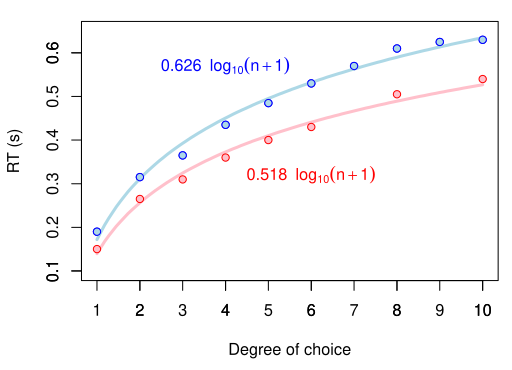Hick's Law
The more choices, the longer the decision time; design for simplicity.
"The time to make a decision increases with the number of choices."

Hick's Law, or Hick-Hyman law, named after British and American psychologists William Edmund Hick and Ray Hyman, states that the time required to make a decision increases logarithmically with the number of choices available. In other words, the more options a person has, the longer it takes to decide.
In Agile environments, where rapid decision-making and adaptability are key, excessive choices can lead to decision fatigue, delays, and inefficiency. Understanding and applying Hick's Law can help teams streamline their processes, improve focus, and enhance productivity.
Impact on Agile Teams and Organizations
Agile methodologies emphasize fast feedback loops, iterative development, and continuous improvement. However, too many choices in any aspect, whether in backlog refinement, prioritization, tooling, or work processes, can hinder agility by:
- Slowing Down Decision-Making:
- Teams take longer to decide on priorities, tools, or strategies.
- Creating Cognitive Overload:
- Developers, Product Owners, and stakeholders may feel overwhelmed with too many options.
- Reducing Efficiency:
- Increased decision time means less time for actual work.
- Delaying Product Delivery:
- The more time teams spend evaluating choices, the slower they deliver value.
- Encouraging Analysis Paralysis:
- Teams may hesitate to act because they fear making the wrong decision.
Scenario
An Agile team is refining their Product Backlog. The Product Owner presents 50 user stories for consideration. The team struggles to prioritize, debating multiple options, trade-offs, and dependencies. Sprint Planning is delayed because:
- Developers feel overwhelmed by the volume of choices.
- Stakeholders have conflicting opinions on what should be prioritized.
- The Scrum Master notices that decision fatigue is setting in.
As a result, the team loses momentum and struggles to maintain a steady flow of work.
Ways to Mitigate Hick's Law:
- Reduce the Number of Options:
- Backlog Prioritization: Limit the number of items in the backlog to a manageable size (e.g., focusing on the top 10-20 items).
- Decision Frameworks: Use methods like MoSCoW (Must-have, Should-have, Could-have, Won't-have) or Eisenhower Matrix to quickly filter options.
- Implement Timeboxing:
- Encourage timeboxed discussions (e.g., 5-10 minutes per major decision).
- Use Defaults and Constraints:
- Set default options for common decisions (e.g., pre-approved tech stacks, standard estimation methods).
- Reduce complexity by limiting choices in frameworks, tools, or methodologies.
- Empower Decision-Making at the Right Level:
- Encourage decentralized decision-making by allowing teams to make choices within their scope.
- Use Decision Trees or Delegation Poker to clarify who decides what.
- Improve Information Clarity:
- Provide clear, data-driven insights to aid decisions (e.g., velocity trends, customer feedback, business impact).
- Keep user stories well-defined using INVEST criteria (Independent, Negotiable, Valuable, Estimable, Small, Testable).
Conclusion:
Hick's Law highlights the negative impact of too many choices on decision speed and efficiency. Agile teams and organizations must be mindful of decision overload and proactively simplify, prioritize, and structure their decision-making processes. By reducing complexity, implementing constraints, and fostering clear decision frameworks, teams can enhance agility, productivity, and focus.
Key Takeaways
- More choices slow down decision-making - Agile teams must limit options to stay efficient.
- Decision fatigue reduces productivity - Prioritization and structured discussions help mitigate this.
- Timeboxing, constraints, and frameworks streamline choices - Teams should use these to stay Agile.
- Empowering teams with clear decision boundaries enhances agility - Decentralized decision-making prevents bottlenecks.
Summary
Hick's Law emphasizes that decision time increases with more choices, which can hinder Agile teams. Too many backlog items, tools, or priorities can lead to delays, inefficiency, and cognitive overload. To counteract this, Agile teams should reduce complexity, use decision frameworks, timebox discussions, and empower decentralized decision-making. By doing so, they ensure faster, clearer, and more effective decisions, driving agility and business value.